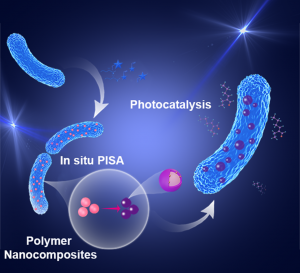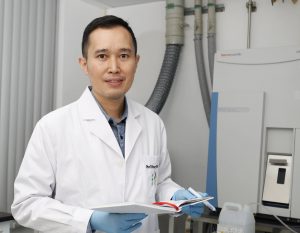A research team led by Henry Kwok Hang Fai, professor in the Faculty of Health Sciences (FHS) at the University of Macau (UM), in collaboration with Geng Jin, Distinguished Professor at the Shenzhen Institute of Advanced Technology, Chinese Academy of Sciences (SIAT), and Dai Zhuojun, a researcher at SIAT, has introduced a novel strategy based on intracellular polymerisation-induced self-assembly (iPISA). This enables the in situ synthesis of gold-polymer nanocomposites within living Escherichia coli, effectively transforming the bacteria into ‘living nanofactories’. This technique is eco-friendly and highly efficient, and is expected to have applications in the fields of medicine, environmental protection, energy, and electronics. The research has been published in the internationally renowned journal Angewandte Chemie International Edition.
Using living biological systems as a platform for material synthesis has emerged as a key area of research in developing functional nanocomposites. Compared to conventional in vitro synthesis methods, intracellular in situ synthesis offers several advantages, including environmental friendliness, mild reaction conditions, and precise spatial control. Therefore, a major technical challenge that urgently needs to be addressed is how to effectively harness the capabilities of cells as ‘natural reactors’ to direct the intracellular synthesis of complex nanostructures.
The research team designed a series of macro-chain transfer agents (macro-CTAs) with different structures and charge properties. These agents initiate self-assembly within cells via the RAFT polymerisation mechanism. The results revealed that macro-CTAs with different charge characteristics exhibited markedly different interactions with the cell membrane, which in turn directly influenced the spatial distribution of the resulting materials. Some formulations demonstrated a predominant tendency to form nanocomposites within the cell, while others were primarily localised on the cell surface. These findings offer a viable strategy for controlling the synthesis location of nanomaterials: by adjusting key components of the reaction system, functional materials can be constructed either intracellularly or extracellularly.
This system also demonstrated strong potential for functional expansion beyond material synthesis. The research team further employed E. coli loaded with gold-polymer nanocomposites to investigate photocatalytic reactions. The results showed that these bacterial hybrids were capable of catalysing aldol condensation reactions under mild conditions, efficiently producing 2-ethylhexenal. Moreover, the gold nanoparticles embedded in the nanocomposites were found to absorb visible light and generate high-energy electrons, thereby enhancing the photocatalytic activity of the polymer matrix. The system also exhibited excellent efficiency in Rhodamine B degradation experiments, highlighting its potential applications in environmental remediation.
This study demonstrates the unique advantages of using living bacteria for the in situ synthesis of nanocomposite materials, offering a new strategy for green synthesis. With its ability to regulate reaction intracellular and extracellular behaviours with precision, this approach holds great promise for a wide range of applications in catalysis, sensing, and biomanufacturing.
Henry Kwok Hang Fai, Geng Jin and Dai Zhuojun are the corresponding authors of this study. Zhang Shiling, a doctoral student jointly trained by FHS and SIAT, is the first author. The project was funded by the National Natural Science Foundation of China (File No.: 22475230), the National Key R&D Program of China (File No.: 2024YFF0507803), the Guangdong Province Zhujiang Talent Program (File No: 2019QN01Y127), the Shenzhen Medical Research Fund (File No.: D2403001), the Science and Technology Development Fund of the Macao SAR (File No.: 0027/2022/A1), and the UM–Dr. Stanley Ho Medical Development Foundation ‘Set Sail for New Horizons, Create the Future’ Grant (File No.: SHMDF-VSEP/2024/002). The full version of the research article is available at: https://onlinelibrary.wiley.com/doi/10.1002/ange.202504936.
| Source: Faculty of Health Sciences | |
| Media Contact Information: | |
| Communications Office, University of Macau | |
| Albee Lei | Tel: (853) 8822 8004 |
| Bell Leong | Tel: (853) 8822 8009 |
| Email: | prs.media@um.edu.mo |


